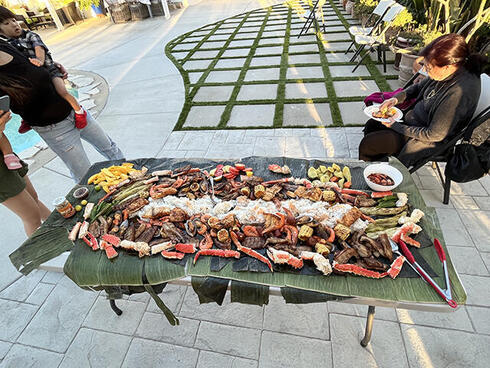It won’t take you long to find out that Filipinos are big fans of bananas. Desserts like turon, bananacue, and maruya have been favorites of mine since I was little. You might have even heard about our famous banana ketchup! But what you might be surprised to learn is that we don’t just use the bananas themselves. In fact, banana leaves are a staple in everyday life and have a multitude of different uses. From wrapping and prepping food, creating table covers, and even treating wounds—these versatile leaves have endless possibilities. From a young age, I witnessed my family using them for all of these purposes and more—my favorite of which was kamayan.
Kamayan, which literally means “by hand,” is a practice in which you gather around a large table covered with grilled banana leaves and eat without plates and utensils. The food is the main event, but the banana leaves work in a humble way—subtly providing a sweet and nutty flavor to the food placed on them.
Getting everything ready is a very hands-on experience. Every member of my family of 14 works intently to turn ingredients into a rich harmony of colors and flavors—all seasoned with love and laughter.
When I think about these priceless moments, I am grateful that I learned the importance of feeling connected to nature, and not taking our planet’s resources for granted. It was powerful to see how we could avoid single-use plastics by using this centuries-old, innovative practice. Thus, I am saddened when I see the harm that plastic pollution is causing wildlife, ecosystems, and communities today. There’s no simple solution, but WWF’s “No Plastic in Nature” campaign aims to use diverse strategies to help fix a broken system.
Imagine a world in which marine life is flourishing with no plastic bags or old fishing gear in sight. Where communities can come together without fearing the damaging effects of plastic pollution. We need everyone involved to make sure we are driving transformative change and getting to the root of the issue. If we do so, we can reach our goal of creating a world with no plastic in nature by 2030.
I have hope for our world. Those before me have always found ways to preserve and respect the Earth’s resources, and I intend to do the same. Throughout this month and beyond, let’s continue to empower Asian and Pacific Islander voices to fight for the preservation of Earth for generations to come.
Tara Zokaie works on WWF’s Integrated Marketing and Membership team where she helps construct a variety of email communications and analyzes results. She is proud of her Persian and Filipino roots and is always inspired by the communities that have shaped her experience—especially during Asian-American and Pacific Islander Heritage Month.
